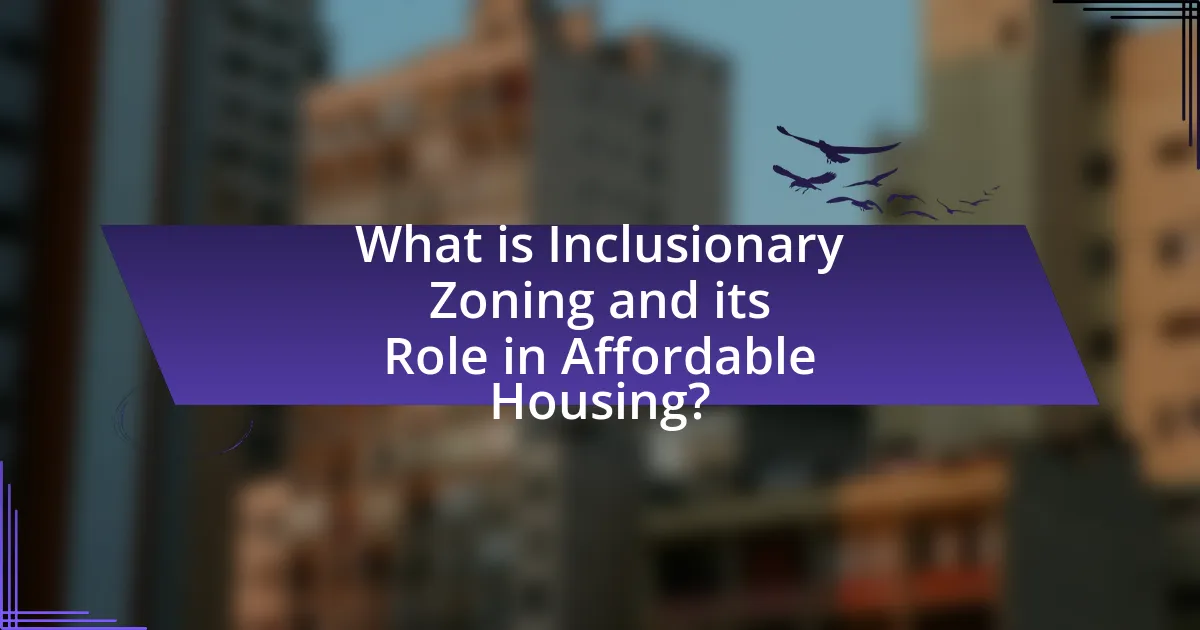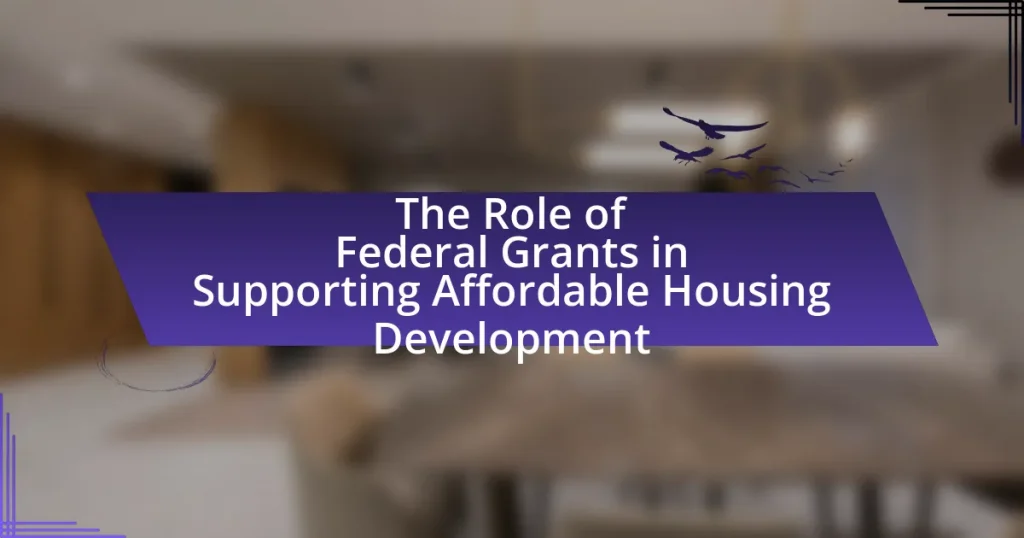Inclusionary zoning is a land-use policy designed to increase the availability of affordable housing by requiring or incentivizing developers to include a percentage of affordable units in new residential developments. This article evaluates the effectiveness of inclusionary zoning as a financing tool for affordable housing, examining its principles, objectives, and the benefits and challenges it presents. Key metrics for assessing its impact, case studies from cities like San Francisco and New York, and strategies for enhancing its effectiveness are discussed, providing a comprehensive overview of how inclusionary zoning can contribute to affordable housing solutions and promote socioeconomic diversity within communities.

What is Inclusionary Zoning and its Role in Affordable Housing?
Inclusionary zoning is a land-use policy that requires or incentivizes developers to include a certain percentage of affordable housing units in new residential developments. This policy aims to create mixed-income communities and increase the availability of affordable housing options for low- and moderate-income households. Studies have shown that inclusionary zoning can effectively increase the stock of affordable housing; for instance, a report by the Urban Institute found that cities implementing such policies saw a significant rise in affordable units, contributing to overall housing affordability in the area.
How does Inclusionary Zoning function as a financing tool?
Inclusionary Zoning functions as a financing tool by requiring developers to include a percentage of affordable housing units in new residential projects, which helps to subsidize the cost of affordable housing. This policy creates a mechanism where the market-driven profits from market-rate units can offset the financial burden of constructing lower-cost units, effectively leveraging private investment to meet public housing needs. For example, cities like San Francisco and New York have implemented Inclusionary Zoning policies that mandate a specific percentage of affordable units, resulting in thousands of affordable homes being built without direct public funding.
What are the key principles of Inclusionary Zoning?
The key principles of Inclusionary Zoning include the requirement for developers to allocate a percentage of new housing units for affordable housing, the establishment of incentives for developers to participate, and the integration of affordable units within market-rate developments to promote socioeconomic diversity. These principles aim to increase the supply of affordable housing while ensuring that it is distributed throughout communities, thereby fostering inclusive neighborhoods. Evidence from various municipalities shows that Inclusionary Zoning can effectively increase affordable housing stock; for instance, San Francisco’s program has produced thousands of affordable units since its inception in 2002.
How does Inclusionary Zoning differ from other housing policies?
Inclusionary Zoning differs from other housing policies by mandating that a certain percentage of new residential developments be affordable for low- to moderate-income households. This policy directly integrates affordable housing into market-rate developments, unlike other housing policies that may rely on separate funding mechanisms or incentives. For instance, traditional housing policies often utilize subsidies or tax credits to support affordable housing projects, which can lead to a lack of integration within communities. Inclusionary Zoning, as implemented in cities like San Francisco, has resulted in the creation of thousands of affordable units within mixed-income neighborhoods, demonstrating its effectiveness in promoting social equity and diversity in housing.
What are the objectives of Inclusionary Zoning?
The objectives of Inclusionary Zoning are to increase the supply of affordable housing, promote socioeconomic diversity, and ensure that low- and moderate-income households have access to housing in various neighborhoods. By mandating or incentivizing developers to include a percentage of affordable units in new residential projects, Inclusionary Zoning aims to address housing shortages and reduce economic segregation. Studies have shown that cities implementing Inclusionary Zoning have seen a measurable increase in affordable housing stock, contributing to more equitable community development.
How does Inclusionary Zoning aim to increase affordable housing supply?
Inclusionary Zoning aims to increase affordable housing supply by requiring developers to include a percentage of affordable units in new residential projects. This policy incentivizes the creation of affordable housing by allowing developers to benefit from density bonuses, reduced parking requirements, or expedited permitting processes in exchange for providing affordable units. Studies have shown that cities implementing Inclusionary Zoning have successfully increased the number of affordable housing units; for instance, San Francisco’s program resulted in over 1,500 affordable units being built between 2005 and 2015.
What social equity goals does Inclusionary Zoning address?
Inclusionary Zoning addresses social equity goals by promoting affordable housing access for low- and moderate-income households within market-rate developments. This policy aims to reduce economic segregation and ensure diverse communities by requiring developers to include a percentage of affordable units in new residential projects. Evidence from various cities indicates that Inclusionary Zoning can lead to increased housing opportunities for marginalized groups, thereby fostering social integration and equity in urban environments.

What are the Benefits and Challenges of Inclusionary Zoning?
Inclusionary zoning offers benefits such as increasing the availability of affordable housing and promoting socioeconomic diversity within communities. By requiring developers to include a percentage of affordable units in new housing projects, municipalities can address housing shortages and ensure that lower-income residents have access to housing options. For instance, cities like San Francisco and New York have implemented inclusionary zoning policies that have successfully added thousands of affordable units to their housing stock.
However, inclusionary zoning also presents challenges, including potential pushback from developers and the risk of reduced overall housing production. Developers may argue that the requirements increase construction costs, which can lead to fewer new projects being initiated. Additionally, if the affordable units are not well-integrated into the market, it can result in stigmatization and segregation rather than true inclusion. Studies have shown that while inclusionary zoning can be effective, its success often depends on local market conditions and the specific design of the policy.
What advantages does Inclusionary Zoning provide to communities?
Inclusionary Zoning provides communities with increased access to affordable housing, promoting socioeconomic diversity. This zoning policy requires developers to include a percentage of affordable units in new residential projects, which helps to mitigate housing shortages and reduce displacement of low-income residents. Studies indicate that areas implementing Inclusionary Zoning have seen a rise in affordable housing stock, with cities like San Francisco and New York reporting thousands of affordable units created through such policies. Additionally, Inclusionary Zoning can enhance community cohesion by fostering mixed-income neighborhoods, which can lead to improved social outcomes and reduced economic segregation.
How does Inclusionary Zoning contribute to economic diversity?
Inclusionary Zoning contributes to economic diversity by mandating that a percentage of new housing developments be affordable for low- and moderate-income households. This policy creates mixed-income communities, which can reduce economic segregation and promote social integration. For instance, cities like San Francisco and New York have implemented Inclusionary Zoning policies that have resulted in thousands of affordable units, thereby allowing diverse economic groups to coexist in the same neighborhoods. Studies indicate that such mixed-income developments can enhance local economies by increasing consumer spending and fostering a more inclusive community environment.
What are the long-term benefits of Inclusionary Zoning for urban development?
Inclusionary Zoning provides long-term benefits for urban development by promoting affordable housing, enhancing community diversity, and stabilizing neighborhoods. By mandating that a percentage of new housing units be affordable for low- to moderate-income residents, Inclusionary Zoning helps to increase the overall supply of affordable housing, which can alleviate housing shortages. Studies, such as those conducted by the Urban Institute, indicate that cities implementing Inclusionary Zoning have seen a measurable increase in affordable units, contributing to a more balanced socio-economic landscape. Additionally, diverse communities foster social cohesion and economic resilience, as varied income levels can stimulate local economies and reduce reliance on public assistance. Over time, these benefits contribute to the sustainability and vibrancy of urban areas, making them more attractive for investment and development.
What challenges and criticisms does Inclusionary Zoning face?
Inclusionary Zoning faces several challenges and criticisms, primarily related to its effectiveness and impact on housing markets. Critics argue that it can lead to reduced overall housing supply, as developers may opt to build fewer units or withdraw from the market due to increased costs associated with including affordable units. Additionally, there are concerns that Inclusionary Zoning may not adequately address the needs of the lowest-income households, as the affordable units created are often targeted at moderate-income families rather than those in extreme poverty. Studies have shown that in some jurisdictions, the implementation of Inclusionary Zoning has resulted in higher housing prices, as developers pass on costs to consumers. Furthermore, the administrative complexity and variability in local policies can create barriers to successful implementation, leading to inconsistent outcomes across different regions.
How can Inclusionary Zoning lead to unintended consequences?
Inclusionary zoning can lead to unintended consequences such as reduced overall housing supply and increased housing costs. When developers are required to include affordable units in their projects, they may respond by increasing prices on market-rate units to offset the costs, which can ultimately make housing less affordable for all. A study by the Urban Institute found that in some markets, inclusionary zoning policies resulted in a decrease in new housing construction, as developers opted to build in areas without such requirements, thereby exacerbating housing shortages. Additionally, these policies can lead to the concentration of affordable housing in specific neighborhoods, which may perpetuate socio-economic segregation rather than promoting diverse communities.
What are the common criticisms regarding its effectiveness?
Common criticisms regarding the effectiveness of inclusionary zoning as a financing tool for affordable housing include its limited impact on overall housing supply and potential negative effects on market dynamics. Critics argue that inclusionary zoning often results in a minimal number of affordable units being produced relative to the total housing stock, which may not significantly alleviate housing shortages. Additionally, some studies indicate that such policies can lead to increased housing prices in the broader market, as developers may pass on costs associated with affordable unit requirements to buyers or renters. For instance, a report by the Urban Institute found that in certain markets, inclusionary zoning did not lead to a measurable increase in affordable housing availability, raising concerns about its overall efficacy as a solution to housing affordability issues.

How Effective is Inclusionary Zoning as a Financing Tool?
Inclusionary zoning is an effective financing tool for affordable housing, as it mandates a percentage of new developments to be set aside for low- and moderate-income residents. This approach has been shown to increase the supply of affordable units without requiring direct public funding. For instance, a study by the Urban Institute found that cities implementing inclusionary zoning policies saw a 15% increase in affordable housing stock over a decade. Additionally, inclusionary zoning can leverage private investment, as developers often benefit from density bonuses or expedited permitting in exchange for including affordable units, thus creating a win-win scenario for both developers and communities.
What metrics are used to evaluate the effectiveness of Inclusionary Zoning?
Metrics used to evaluate the effectiveness of Inclusionary Zoning include the percentage of affordable units created, the income levels of households benefiting from these units, and the overall impact on housing market dynamics. The percentage of affordable units indicates how well the policy meets its goal of increasing affordable housing stock, while analyzing income levels helps assess whether the units are accessible to low- and moderate-income families. Additionally, examining housing market dynamics, such as changes in property values and rental rates in areas with Inclusionary Zoning, provides insight into the policy’s broader economic effects. Studies have shown that effective Inclusionary Zoning can lead to a significant increase in affordable housing availability, with some jurisdictions reporting up to 20% of new developments designated for affordable units.
How do we measure the impact on affordable housing availability?
The impact on affordable housing availability is measured through various quantitative and qualitative metrics, including changes in housing stock, affordability indices, and occupancy rates. For instance, tracking the number of affordable units created or preserved in a given area provides a direct measure of availability. Additionally, analyzing the percentage of income that households spend on housing can indicate affordability levels, with a common benchmark being that housing costs should not exceed 30% of a household’s income. Studies, such as those conducted by the Urban Institute, have shown that inclusionary zoning policies can lead to an increase in affordable housing units, thereby demonstrating their effectiveness as a financing tool.
What data is available to assess the success of Inclusionary Zoning policies?
Data available to assess the success of Inclusionary Zoning policies includes metrics such as the number of affordable units created, the percentage of affordable housing in new developments, and demographic data of residents in these units. Additionally, studies often analyze housing market trends, rent levels, and displacement rates in areas with Inclusionary Zoning compared to those without. For instance, research conducted by the Urban Institute in 2020 found that cities implementing Inclusionary Zoning saw a 15% increase in affordable housing stock over five years, indicating a positive impact on housing availability.
What case studies illustrate the effectiveness of Inclusionary Zoning?
Case studies that illustrate the effectiveness of Inclusionary Zoning include the programs implemented in San Francisco, California, and Montgomery County, Maryland. In San Francisco, the Inclusionary Housing Program has resulted in the creation of over 1,500 affordable units since its inception in 2002, demonstrating a significant impact on housing availability for low-income residents. Similarly, Montgomery County’s Moderately Priced Dwelling Unit (MPDU) program has produced more than 14,000 affordable units since 1974, effectively integrating affordable housing into various neighborhoods. These examples provide concrete evidence of how Inclusionary Zoning can successfully contribute to affordable housing development in urban areas.
What lessons can be learned from successful Inclusionary Zoning implementations?
Successful Inclusionary Zoning implementations demonstrate that clear policy frameworks and community engagement are essential for effectiveness. These frameworks establish specific requirements for developers to include affordable units, which can lead to increased housing diversity and accessibility. For instance, cities like San Francisco and New York have seen positive outcomes when developers are incentivized through density bonuses or streamlined permitting processes, resulting in a higher percentage of affordable housing units. Additionally, ongoing collaboration with community stakeholders ensures that the needs of low-income residents are met, fostering public support and reducing opposition to new developments. Data from various studies indicate that cities with robust Inclusionary Zoning policies have successfully increased their affordable housing stock, highlighting the importance of tailored approaches that consider local market conditions and community needs.
How do different regions compare in their use of Inclusionary Zoning?
Different regions exhibit significant variation in their use of Inclusionary Zoning (IZ), with some areas implementing robust policies while others adopt minimal or no measures. For instance, cities like San Francisco and New York have established mandatory IZ policies that require developers to include affordable units in new housing projects, often setting specific percentages for affordability. In contrast, regions such as Houston have no formal IZ policies, relying instead on market-driven solutions for housing affordability. Studies indicate that regions with strong IZ frameworks, like the Bay Area, have seen a higher percentage of affordable housing units created compared to those with weaker or non-existent policies, highlighting the effectiveness of IZ as a tool for addressing housing shortages.
What best practices can enhance the effectiveness of Inclusionary Zoning?
Best practices that can enhance the effectiveness of Inclusionary Zoning include establishing clear and consistent policies, ensuring adequate incentives for developers, and incorporating community engagement in the planning process. Clear policies provide a framework that guides developers and local governments, reducing ambiguity and increasing compliance. Adequate incentives, such as density bonuses or tax abatements, encourage developers to participate in Inclusionary Zoning programs, making affordable housing projects more financially viable. Community engagement fosters transparency and aligns the zoning initiatives with local needs, which can lead to greater public support and successful implementation. Research indicates that cities with well-defined Inclusionary Zoning policies and strong community involvement see higher rates of affordable housing development, demonstrating the importance of these best practices.
How can community engagement improve Inclusionary Zoning outcomes?
Community engagement can significantly improve Inclusionary Zoning outcomes by fostering collaboration between developers, local governments, and residents, leading to more tailored and effective housing solutions. Engaged communities can provide valuable insights into local needs and preferences, ensuring that the affordable housing created through Inclusionary Zoning aligns with the specific demands of the area. For instance, studies have shown that when community members participate in the planning process, projects are more likely to address issues such as location, design, and amenities, which enhances overall satisfaction and acceptance of new developments. Additionally, community engagement can build trust and transparency, reducing opposition to projects and facilitating smoother implementation. This collaborative approach has been evidenced in cities like San Francisco, where community input has led to successful Inclusionary Zoning policies that better reflect the needs of diverse populations.
What strategies can be employed to address the challenges of Inclusionary Zoning?
Strategies to address the challenges of Inclusionary Zoning include enhancing stakeholder engagement, providing financial incentives, and implementing flexible zoning regulations. Engaging stakeholders, such as developers, community members, and local governments, fosters collaboration and ensures that diverse perspectives are considered, which can lead to more effective policies. Financial incentives, such as tax breaks or subsidies for developers who include affordable units, can encourage participation in Inclusionary Zoning programs. Additionally, flexible zoning regulations that allow for adjustments based on local market conditions can help mitigate the negative impacts on housing supply and affordability. These strategies are supported by studies indicating that successful Inclusionary Zoning programs often incorporate stakeholder input and adaptive policies to meet community needs.



